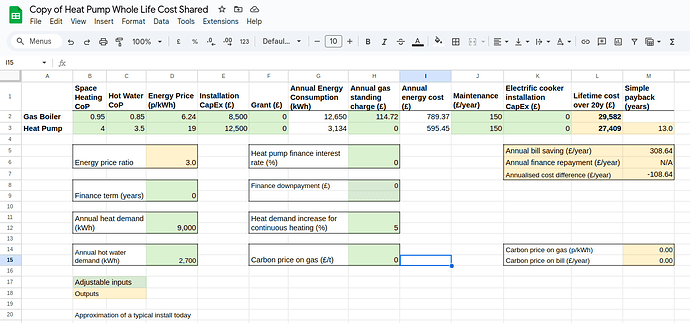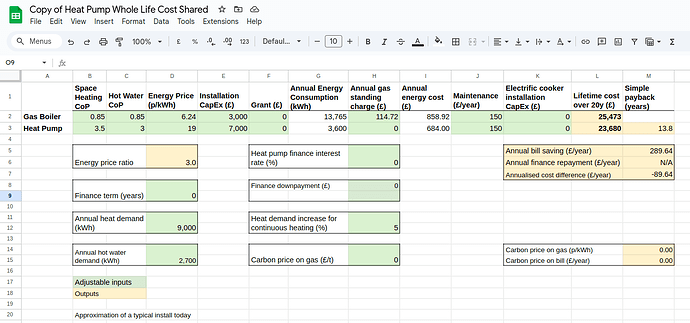What an absolutely fantastic thread. Some really great stories and data.
This is timely because I have been looking at this for my own install recently.
I had a heat pump installed in Nov 2023 (monitoring from Feb 2024) and PV/batteries installed in June 2024. It’s hard for me to separate out the benefits of each of these. I live in a mid-terraced 1900s house with relatively recently converted loft, solid brick walls, crap double glazing. I estimated my heat loss at 5.5 kW, my installer (after much bullying from me) got his calc down to 6.5 kW. I twisted his arm and got him to install the 5 kW Vaillant Arotherm. The heat demand explorer suggests 4 kW is more realistic. All rads sized to 50 degree flow but in reality flow temp is in the range of 28-33, so rads are “undersized” to deliver the heat at that flow temp (but balanced out by them being oversized for the room actual heat losses). This culminates (I think) in getting quite a low delta T between flow and return - usually ~2 degrees. I hypothesize that the radiators cannot lose enough heat into the room at a flow temp that low, so the return temp is higher than it otherwise would be. Unsure if that has any impact on efficiency.
My heat pump install also included extract fan and induction hob installations.
- EPC (needed for BUS): £95
- ASHP + 200L Cylinder: £5,680
- Plumbing labour: £5,500
- 7no. Radiators + valves: £2000 (went for nicer rads than K2/K3 which only added a few £hundred)
- Pipes, pipe fittings, fixtures, base: £1,890
- MCS “piggyback”: £1,320 (grrr)
- Elec materials: £780
- Labour and materials for hot water cylinder cupboard: £1,290
- Hob £150 (off Facebook market place)
- Extract fan £250 (Vent Axia heat recovery fan, off ebay)
- Metering/monitoring £710
- BUS -£7,500
So say £10.5-11k for the base heat pump install all in inc grant and just over £12k including the nice-to-haves.
PV
- 2kW of panels (max I can fit on roof) + 3.7 kW inverter + 9.3 kWh of battery storage, estimated generation 1,800 kWh/annum: £7,400
Call it £20k for the lot.
Comparing bills
Last full year
Nov 22-Oct 23 ~£1,220
Nov 23-Oct 24 ~£790
£430/annum saving = 47 year “payback”
Just the period which I have had PVs
Jun 23-Oct 23 ~£310
Jun 24-Oct 24 ~£100 (most of which is standing charge)
5 month saving extrapolated over year = £500/annum = 40 year “payback”
I’ve also had a look at what I would be paying if I was still using gas, but was keeping the house as comfortable as I now do with the heat pump over the period I have had heat meter data available.
Feb 24-Oct 24 actual: £430
Feb 24-Oct 24 if using gas: £790
9 month saving extrapolated over year = £500/annum = 40 year “payback”
I’ve been on agile since July.
Monthly bills inc VAT, export and standing charges
July £8.50
Aug £5.00
Sep £23.00
Oct £41.00
My COP is 2.4-2.8 in summer (hot water only) and 3.8-5 in heating season. Current average for the year is 4 and increasing. My COP climbs dramatically in the colder weather but obviously this comes at the cost of overall energy consumption also increasing. This is why I think a pure focus on COP is a bit short-sighted.
I have looked at my unit cost of heat. This includes all standing charges, grid charges, export income and uses monthly COP.
Feb 7.7p
Mar 8.9p
Apr 8.1p
May 10.2p
Jun 6.1p (PV installed)
Jul 1.8p
Aug 1p
Sep 3.3p
Oct 3.4p
Weighting that over the period by the amount of heat generated I get an average cost of 6.8p/kWh.
My thoughts range from
- people don’t seem to place value on being warm (yet expect it to also be super cheap). But will spend £50k on a kitchen.
- I think optimising for SCOP is the wrong thing…or at least solely focussing on this is misleading. I run my heat pump for 9 hours a day. It might have a slightly lower efficiency for those 9 hours, but the 15 hours of not running it definitely saves energy! Better to generate 4,000 kWh of heat when you need it at a SCOP of 4 than 6,000 kWh at a SCOP of 5.
- I think self-learning or simpler systems really are what is needed for Joe public.
- A focus on return on investment “penalises” already frugal users. At a fixed cost of the plant and labour cost, then the saving from reducing energy from 10,000 to 4,000 kWh is going to offer a significantly quicker payback time than going from 4,000 to 1,600 kWh. That doesn’t mean the work is any less worth doing, or that being frugal is a bad thing!
- On a related thread, the lower the energy consumption, the greater the impact of the standing charge.
- I got quotes for new glazing. Triple glazing surprisingly not that much more expensive double. Overall the cost would have been £7k and offered pretty limited impact on total heat loss. I didn’t get quotes for external wall insulation, I expect that would be £10-15k. Would probably make more of a difference than improving the glazing. I guess my point is you can spend a lot of money and still be burning gas. Much better to just get a heat pump.
- Designing to the 95%ile external temperature would likely save a reasonable amount of cash for certain items like the heat pump itself, emitters and possibly also pipework. In most cases designing to 21 degrees at -4 I think is unnecessary. What about 19 at -2? OK, if gets to -4 you might have to put a blanket on but you’ll still feel pretty toasty relative to outside. Human comfort is adaptive, hence why coming into a 16 degree house when it’s 0 degrees outside feels warm, but go into the freezer aisle of a supermarkert on a summer’s day feels cold.
Ultimately for me the possible “Return on Investment” is that we might still be clinging onto a habitable planet in 50 years time.

